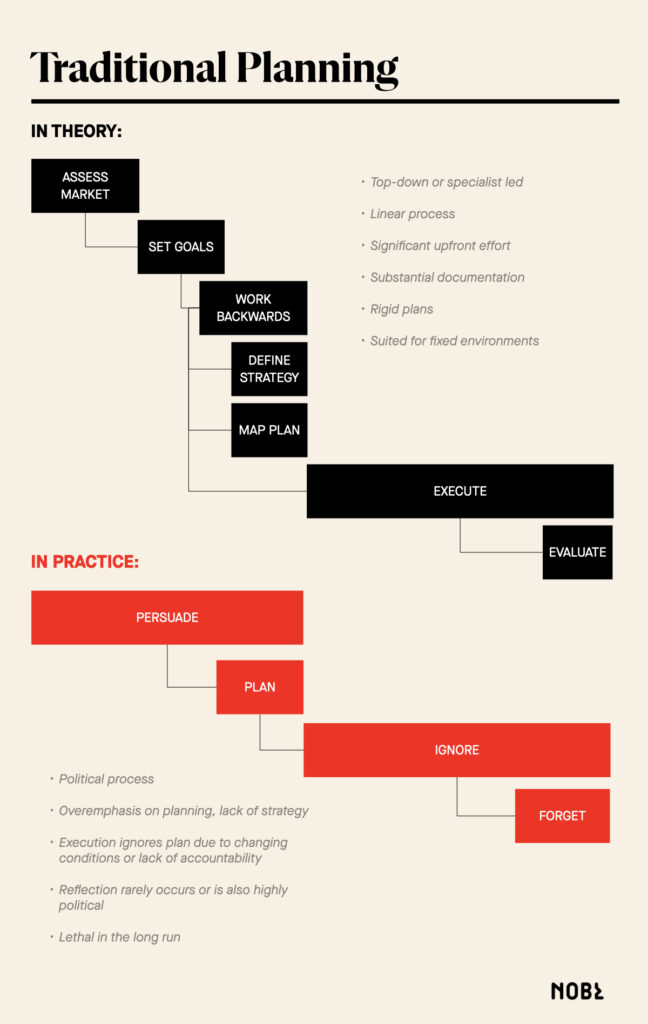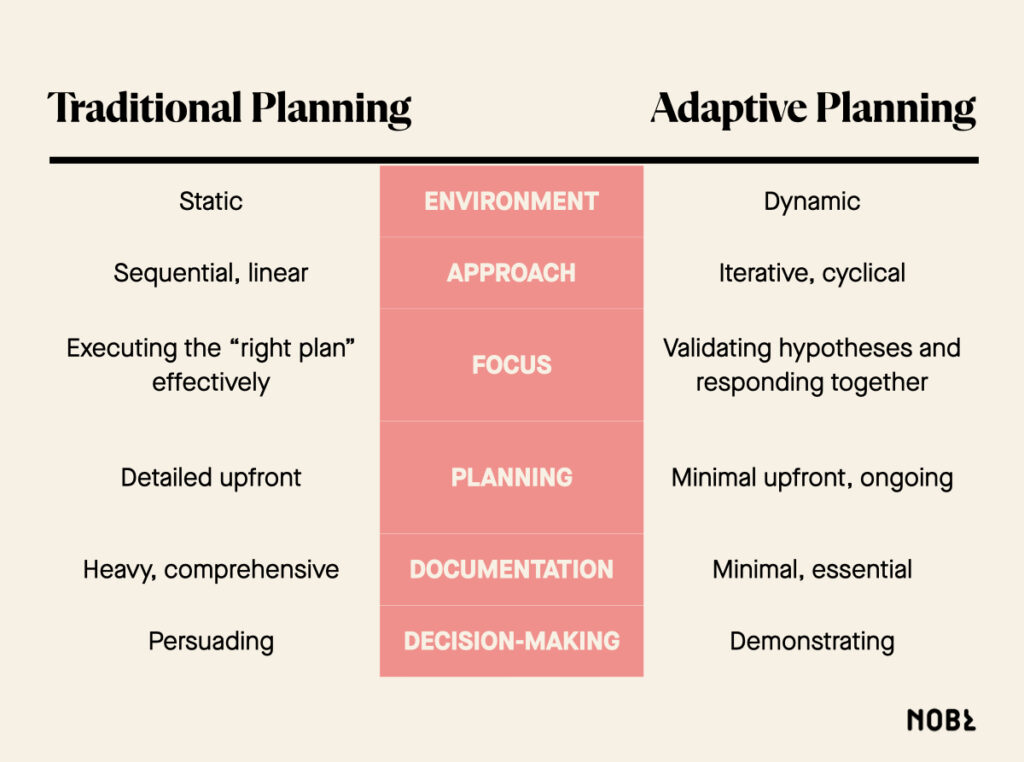Table of contents
So many leaders with incredible visions and strategic ideas have the same complaint: “our teams just aren’t making it happen.” In fact, one study of 400 global CEOs found that “between two-thirds to three-quarters of large organizations struggle with execution” while according to Gartner, “70% of chief strategists express little confidence in their ability” to close the strategy execution gap.
Despite these figures, the strategy execution gap isn’t inevitable: there’s an explanation for why it occurs, and what savvy leaders can do to mitigate it.
What Is the Strategy Execution Gap?
The strategy execution gap is the difference between what a company wants to achieve and what it actually achieves because of organizational and operational weaknesses.
You may have fallen into this gap if you’re seeing:
- Missed deadlines or lack of visible progress. The most obvious sign is what isn’t happening. Goals aren’t being hit. Changes aren’t being made. In the worst case scenario, leaders come together to set next year’s strategy—and realize nothing’s changed since last year’s.
- More strategy talk than action. Leaders spend hours finessing a 100-slide deck. A big rally is held, featuring slogans like “Customer-First” or “Forward Together.” Meetings are called to discuss goals and plans—but there’s little emphasis on how to execute those plans.
- Constant changes in direction. One month, it’s “speed.” The next, “quality.” Employees don’t know what’s most important, or what projects to prioritize. Worse: just 37% of corporate leaders believe their organization has a clear strategy. 35% think it will succeed.
- Confusion among employees. Work slows down because it’s not clear who’s doing what, or who to turn to for help. Critical processes are missing or broken. And in the background, a political battle is brewing over decision-making rights.
- Disconnected teams. Divisions work in silos rather than collaborate because that’s how they’re measured—or worse, they’re specifically instructed not to share information with other teams.
- Burnout and turnover. Teams are working harder than ever, but not getting the desired results. Individuals are frustrated by competing priorities and contrasting marching orders. And your best performers look for opportunities elsewhere.
This failure to execute isn’t just an inconvenience. It’s a real threat to organizational performance: executives believe they lose nearly 40% of the value of their strategies due to poor or lacking execution. And according to Gartner, companies that better execute their strategies are three times more likely to report above average growth, and twice as likely to have above-average profits.
A strategy, even a great one, doesn’t implement itself. – Jeroen de Flander
Why the Strategy Execution Gap Exists

While there’s no one “silver bullet” to fix the strategy execution gap, there is a common underlying cause. Historically, traditional strategic planning processes have moved in one direction, from “planning” to “doing,” and from the top, down. And in a relatively static market, this works, resulting in clear objectives that can be cascaded down through different divisions.
In today’s dynamic markets, though, it’s a disaster. Research from London Business School Professor Donald Sull has demonstrated that this results in leaders creating a strategy early on when they know the least, resulting in false assumptions and bad bets. But since there’s no room for iteration, leaders are forced to execute on a failing plan. And on top of that, competitive pressures mean that organizations are trying to execute their failing plans, faster.
To escape this trap, organizations must adopt iterative, continuous cycles that rapidly alternate between planning and doing. According to Professor Sull, readers must learn to lead teams through four phases:
- Sense Making. Teams must collect information and come to a shared understanding of how events might unfold in the immediate future—in other words, one iterative cycle.
- Deciding. Leaders must make trade-offs to focus the organization’s resources on what to do (or not do).
- Doing. Teams commit to actions aligned with the decisions, and then implement those actions. (Easy, right?)
- Revising. Teams must come back together to assess the results of their actions, and make revisions for the next iteration.
While this all makes sense in theory, of course, applying it can be quite daunting. It requires:
- Organizations to develop a new cadence of meetings to hold these conversations
- Leaders to potentially develop new skills like creating space for open debates and getting feedback
- Teams to adopt new habits for experimenting and executing ideas
- And new processes and systems to make decisions, share information, track performance, and more
Again, daunting—but necessary. And the good news is: it’s completely possible, even at legacy organizations. We know, because we’ve done it.
What about Scenario Planning?
Scenario planning can be a useful exercise, but not because it can meaningfully predict the future. Instead, it can be used to identify activities that make sense in a wide variety of outcomes, and potential “bets” to make. But arguably the biggest benefit is giving teams practice in identifying and discussing signals in the market, and how to respond.
How to Bridge the Gap
Let’s execute along this strategy, but know that we’ll probably get some of this wrong, so be open to changing it. – A.G. Lafley

One of the fastest-growing companies in US history faced exactly this challenge. For years, their traditional planning process impeded their ability to coordinate teams and plan work at the speed of their demand. With future growth threatened, NOBL worked with the CEO to implement a more adaptive, iterative approach to strategic planning:
- The CEO worked with us to rally the Executive team around a simplified strategy, deciding trade-offs and differentiating between critical work and opportunistic bets.
- We then helped them develop shared language and consistent messaging, checking for understanding and adjusting as necessary.
- We established learning roundtables to bring different divisions together to discuss both progress and challenges, fostering cross-functional collaboration. In addition, these roundtables fueled teams’ curiosity and made it safe to focus on progress, not perfection.
- This feedback was then laddered up the organization, where it informed strategy modifications and coordination.
If you’re evaluating the need for a new approach at your organization to bridge the strategy execution gap, we recommend starting by:
- Building the practices of sense making and revision through a retrospective. Bring together a small team —ideally representing different divisions and layers of the organization—to review last year’s strategic execution. What went well? What didn’t? What could you try doing differently? This is an excellent opportunity to assess your organization’s ability to hold respectful, critical conversations and willingness to hear different perspectives.
- Simplify deciding by aligning on a few basic trade-offs. So often, a so-called strategy is just a list of platitudes, like “teamwork.” Instead, define guidelines that showcase trade-offs between two good outcomes. We call these “even overs.” For instance, an organization working on complex products might accept that they need “Collaboration even over speed,” while a rapidly scaling organization might have to tolerate “growth even over efficiency.”
- Get teams used to doing things different by starting small. Try implementing one or two suggestions from your retrospective, or testing a different approach with one division or region. It may or may not work—keep iterating until you find a good fit. Only then should you consider spreading it to the rest of the organization, or tackling the next part of the challenge.
Need some inspiration? Learn how Amazon applies a rigorous yet inclusive approach to strategic planning.
Signs of Progress
You’ll know your organization is closing the strategy execution gap when you start to see:
- Increased trust between teams. There’s greater transparency and less finger-pointing. Teams know they can count on each other to deliver what was promised.
- Fewer missed deadlines. With greater focus and collaboration, teams now achieve deadlines consistently—and without burning out.
- Incremental adjustments, not dramatic swings. While teams will always be making changes, they’ll be more gradual, not annual shifts that take everyone by surprise.
- Improved morale. While taking on a more experimental approach at first may be uncomfortable, teams quickly appreciate that they’re more actively involved in making change (rather than having change done to them) and that they’re working on the right work—work that contributes to the organization’s larger goals, not busy work or the whims of individual leaders.
Learn more about NOBL’s approach to strategic planning and how we can help your organization achieve more.













